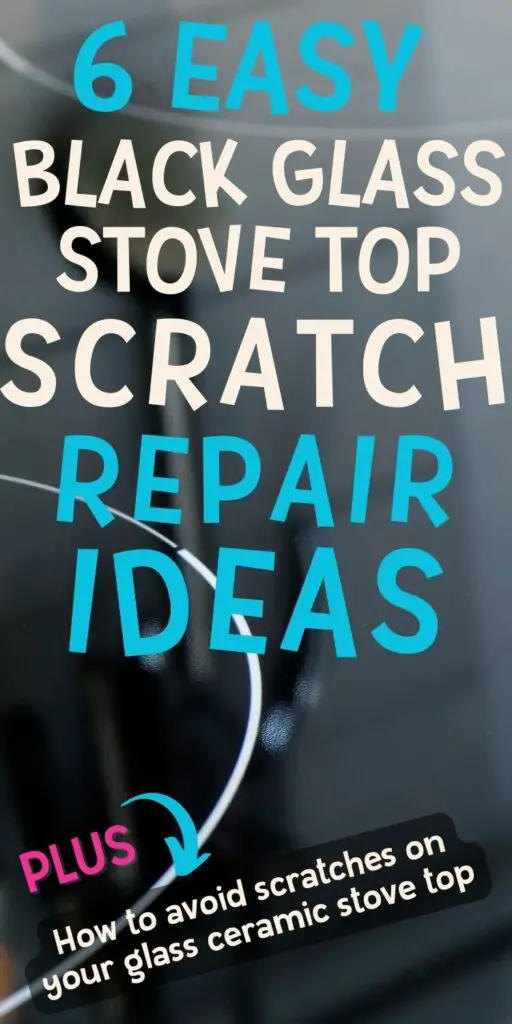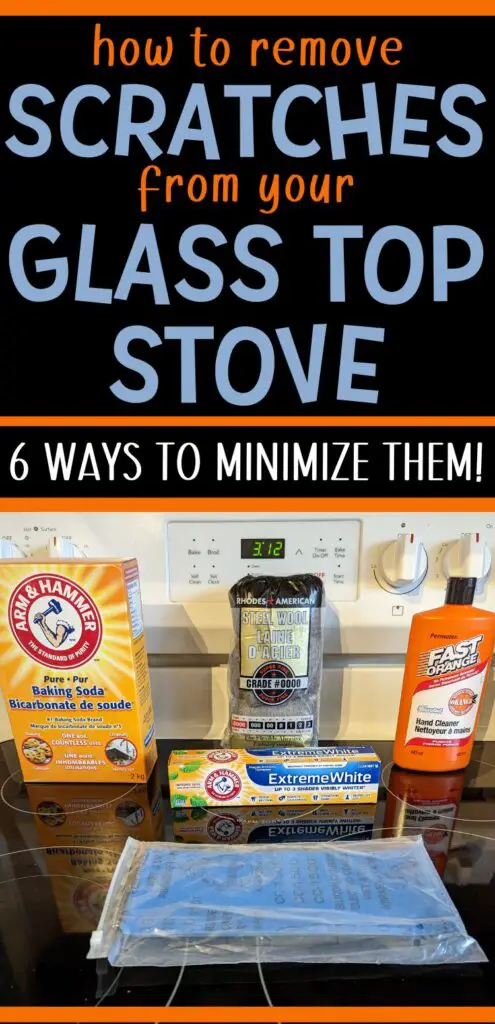Black glass stove tops have many benefits – they heat faster than gas and have more cooking power than electric coils. But they are also susceptible to scratches and other types of damage. Thankfully, there are several black glass stove top scratch repair methods that can help restore your glass top stove’s appearance and many ways to protect it from further damage.
As an Amazon Associate I earn from qualifying purchases. This means if you click on a link and buy something I’ve recommended, I get a small commission at no additional cost to you. You can see my full Disclosure Policy here.

What causes scratches on glass stove tops?
Black glass stove tops are made of a durable tempered ceramic glass blend with coiled metal heating elements underneath the glass. The glass can withstand continuous exposure to high temperatures, but is still brittle and susceptible to scratches from abrasive substances or objects. Scratches on glass stove tops can have many different causes, including:
Cooking utensils
Leaving dirty utensils laying on your glass stovetop allows fats and food to drip onto the glass surface and harden.
Abrasive cleaning products
Abrasive cleaning products or scrubbing pads on the surface of a glass stove top can cause scratches.
Cookware
Some types of cookware with rough or sharp bottoms can scratch the surface of a glass stove top when they are moved around. Additionally, if your pan has any residue baked onto the bottom, it can also cause scratches.
Dirt and debris
Any burnt food can scratch or damage the glass stovetop. Make sure to clean spills as soon as they’re cool enough to safely wipe away. Dirt, sand, or other small mineral particles on the surface of the stove can scratch the glass if it is rubbed or dragged across the surface.
Impact
Dropping a heavy pot or pan on the stove top can cause scratches or even cracks. Items falling out of cabinets above the stove can cause the glass to scratch or break.
RELATED POST: How to remove melted plastic from stove top
Can scratches be removed from glass cooktops?
You can’t completely remove scratches from a glass stove top. However, it is possible to drastically reduce the look and feel of superficial and some surface glass top stove scratches. There are a few different methods you can try, depending on the severity of the scratches and the products you have available.
Related Post: What to do When Your House is Too Hot in Summer
How to prepare to remove scratches from glass top stove
Clean the surface of the glass top stove
It’s important to make sure to thoroughly clean your glass stove top surface. This helps to ensure the marks you are seeing are actually scratches and not deposits of food or other debris.
Assess the scratches on glass stove top
Before attempting your black glass stove top scratch repair, it’s a good idea to assess the severity of the scratches to decide whether you can repair it yourself or if you need to seek professional help. The different types of scratches are:
- Superficial scratches are fine scratches or scuffs that can’t be felt and are hard to see unless you stand at a certain angle. Superficial scratches can be buffed out using any of these black glass stove top scratch repair ideas.
- Surface scratches are shallow and can be felt with your fingernail. While it’s not possible to completely remove surface scratches, it is possible to minimize them with one of these methods.
- Sub-surface scratches are deep scratches that are easily felt with your fingertips. They can form large channels and weaken the integrity of your stove top. Sub-surface scratches could lead to your glass stove top cracking or even a more severe break. You may want to obtain a professional opinion on sub-surface scratches as these methods are unlikely to help.
Once you’ve thoroughly cleaned your glass stove top, determined the type of scratches you have and whether it’s worth the effort, you are ready to move on to removing the scratches. It may take some trial and error to find the right method for your particular stove, so be sure to test a small, inconspicuous area before applying any of these methods to the entire stovetop.
RELATED POST: How to clean a really messy room FAST

How to remove scratches from glass cooktop
Here are five different methods you can try to remove scratches from a glass top stove. Do not use any of these methods on a hot glass stove top – let it cool to room temperature first or you risk creating more scratches.
Baking soda paste
- Mix baking soda with a little water to create a paste.
- Apply the paste to cover the scratched area.
- Use a soft cloth to buff the scratch, using circular motions.
- When the area is smoothed out, wipe away the baking soda residue with a clean cloth and lukewarm water.
- Repeat as required.
Toothpaste
- It’s important to use a tooth paste and not a gel for this method. You will get best results with a baking soda toothpaste.
- Apply a dab of toothpaste to a soft cloth.
- Buff the glass with a soft cloth in circular motions until it feels smooth
- Wipe away any residue with a damp, clean cloth.
- Repeat as required.
Pumice
Pumice is a crumbly light abrasive that is safe to use on glass stove tops to remove scratches. I found that having it premixed in a soap makes it much easier to use for other home cleaning purposes.
- Pour a small amount of liquid pumice soap over the scratch.
- Use a soft cloth to buff the scratch, using circular motions.
- When the area is smoothed out, wipe away any residue with a damp, clean cloth.
- Repeat, if necessary, until smooth.
#0000 Steel wool
While it’s not recommended to use steel wool on your glass stove top on a regular basis, this is an ultra-fine steel wool. It’s an excellent light abrasive that can remove shallow surface scratches and polish the glass without creating more scratches.
- Ensure that the steel wool is grade #0000. Anything else may further scratch your cooktop.
- Spray the scratched area with a thin layer of fresh water to provide lubrication.
- Rub the steel wool pad on the wet glass top in a circular motion. Don’t use too much pressure.
- Wipe with a clean, soft cloth.
- Repeat until smooth.
High grit sandpaper
As with #0000 steel wool, it is not recommended to frequently use high grit sandpaper on your glass top stove. However, for scratches on your cooktop, it offers a balance of an ultra-fine abrasive without risking more scratches
- Wet the sandpaper and the glass surface with water to lubricate. Make sure the area is always wet when you use this method.
- Start with a piece of 3000 grit sandpaper and use a circular motion to buff out the scratch. Buff until the scratch is visibly improved.
- Move up to 5000 grit sandpaper and continue buffing using circular motions until you can barely see the scratch.
- Move up to a 7000 grit sandpaper (continue circular motions) to polish the glass surface smooth.
- Wipe clean with a damp, soft cloth.
Cerium Oxide Based Polish
Another option that I haven’t personally tried yet is to use a polishing compound specifically designed for glass. I have a friend who tried this solution and she told me it worked perfectly on her black glass stove top.
- Apply a small amount of the compound to the scratch.
- Buff it out with a soft cloth in a circular motion.
- Wipe clean with a damp soft cloth.
With this method, you also have the option of using a drill or other rotary tool with a felt polishing pad to buff out the scratches. I feel this would be a good option if you have many scratches on your glass top stove and want to tackle them all at one time.
RELATED POST: Best floor cleaning machines for your home
How to avoid scratches on your glass ceramic stove top
Here are a few different ways you can protect your glass stovetop from scratches and other damage:
- Frequently cleaning your glass top stove can minimize the risk of scratches.
- Make sure to rest utensils on a spoon rest or paper towel.
- Stick with a microfiber cloth, a soft sponge or a blue non-abrasive scouring pad when cleaning your glass stove top.
- Don’t lean in too hard when cleaning your glass stovetop because too much pressure can crack the glass.
- Don’t slide pots and pans over the burners.
- Use pots and pans with a smooth protective layer on the bottom, such as anodized aluminum or copper-bottomed.
- Make sure to keep the bottoms of your pots and pans clean and free of buildup.
- Avoid placing heavy or sharp objects on the surface.
- Use lightweight cookware such as stainless steel.
- Don’t store heavy objects on or above your stove top.
- Use stovetop protectors, which are heat resistant and specially designed to fit over the surface of the stove to protect the glass.
Depending on the severity of the scratches, you may have to use one or more of these glass stove top scratch repair methods to remove scratches from your glass stovetop. If you are only dealing with superficial or surface scratches, try one of these black glass stove top scratch repair ideas. Your glass stove top surface will look (almost) new again!

